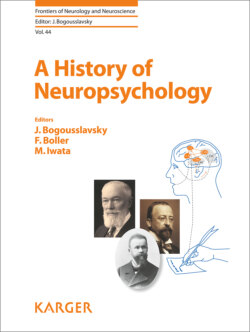Читать книгу A History of Neuropsychology - Группа авторов - Страница 57
На сайте Литреса книга снята с продажи.
Oral Reading
ОглавлениеReading aloud kana words and sentences was on the whole correct, but reading aloud kanji words was severely impaired. As mentioned, a kanji has more than two ways of reading but only one of them is appropriate when it is embedded in a particular kanji-kana mixed sentence. The patient simply misread the kanji part of a sentence, either producing a correct but inappropriate name for the sentence, or confusing it with another kanji similar in form.
To make the point easy to understand for non-Japanese readers, an example of his reading errors is illustrated in Figures 1 and 2. In this reading of a sentence: “Three kaki trees stand outside the gate,” his errors were restricted to kanji characters (Fig. 1). He erroneously read the first kanji meaning gate for “ka-n,” which is a name for other characters similar in form (Fig. 2). The second kanji meaning outside he read as “ga-i,” which is wrong in this sentence but is one of the correct readings of the character (Fig. 3). The third kanji meaning tree should be read as “ki,” but he misread it as “ho-n,” probably confusing it with the visually similar fifth character (Fig. 2). The fourth kanji meaning three he read correctly as “sa-n.” The fifth kanji is usually used as postposition for numbers when counting long objects such as trees or sticks. His reading “po-n” is not acceptable in this context but one of its correct readings (Fig. 3). For example, one tree is counted as “i-ppo-n,” 2 trees as “ni ho-n”, and 3 trees as “sa-n bo-n.”
Fig. 1. Reading performance of Imura’s case E. The first row of the table shows a sentence from a contemporary primary school textbook which is written in mixed kanji and kana characters. Underlined characters are kanji. Others are kana. The second row shows its pronunciation in romanized letters (romaji). Each kana pronunciation is shown separately for the purpose of easy correspondence. Underlined parts correspond to kanji portion. The third row is reading by the patient. Errors are shown in italics and underlines. For details, see text. The fourth row is an English translation of the text [13].
Fig. 2. Reading performance of Imura’s case E. Confusion of kanji forms. The patient misread the first kanji “mo-n” in Figure 1 as “ka-n” which is like in form with such characters meaning quiet, between, or barrier. Also he misread the third kanji “ki” in Figure 1 as “ho-n,” which is similar in form.
Fig. 3. Reading performance of Imura’s case E. Selection errors of pronunciation. The upper kanji in the table has 5 ways of pronunciation. The lower kanji has four. The patient read the upper one (the second kanji in Figure 1) meaning outside as “ga-i, ” which is one of 5 correct readings for the character but wrong for the text. It should be read as “soto.” Similarly, he read the lower kanji (the fifth kanji in Figure 1) as “po-n” which is wrong, although the pronunciation itself for the character is correct. It should be “bo-n.”
